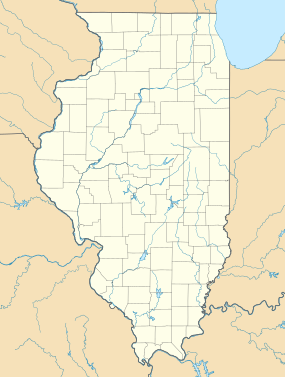Mound 34
| Location |
Collinsville, Illinois, Madison County, Illinois, |
|---|---|
| Region | Madison County, Illinois |
| Coordinates | 38°39′39.06″N 90°3′24.41″W / 38.6608500°N 90.0567806°W |
| History | |
| Cultures | Middle Mississippian culture |
| Site notes | |
| Excavation dates | 1950, 1956, 1999-2010, |
| Archaeologists | James B. Griffin, Albert Spaulding, Gregory Perino |
| Architecture | |
| Architectural styles | platform mound, copper workshop |
Mound 34 is a small platform mound located roughly 400 metres (1,300 ft) to the east of Monks Mound at Cahokia Mounds near Collinsville, Illinois. Excavations near Mound 34 from 2002–2010 revealed the remains of a copper workshop, although the one of a kind discovery had been previously found in the late 1950s by archaeologist Gregory Perino, but lost for 60 years. It is so far the only remains of a copper workshop found at a Mississippian culture archaeological site.
From the Emergent Mississippian period (beginning approximately 800 CE) to the Stirling Phase (1000 to 1200 CE) the location was a village site with multiple houses, pit features, extensive midden deposits, a copper worskop, and a large structure (possibly as large as 10 metres (33 ft) by 6 metres (20 ft)) with a centrally located hearth. Early in the Moorehead Phase (1200 - 1275 CE) the entire area east of Cahokia saw an intensive construction episode. The village area and all of its structures was razed and the "Ramey Plaza" and its associated mounds was built over it. This plaza and its twenty associated mounds are the second largest such grouping at the Cahokia site, after the Grand Plaza area which includes Monks Mound and is encircled by the palisade. Mound 34 lies at the northern end of a string of mounds that define the western edge of the Ramey plaza. This construction required the leveling of the area and the removal of much of the village midden that had accumulated over the previous two centuries of occupation, pp to 2 feet (0.61 m) in some areas. This removed midden material, along with nearby earth from borrow pits, was used to build the mounds. Mound 34 was constructed as a low rectilinear platform mound oriented along a north/south axis maintained by the majority of the Cahokia site, and with a terrace or apron along its west, north, and east sides. The mound had a building constructed on its summit, inside of which was a large circular hearth. The mound displayed signs of at least one further building episode during the Sand Prairie Phase (1275 - 1350 CE), when an additional cap of earth was added over the mound.
Artifacts found during excavations of the site included Mississippian culture pottery, beads made from shell, worked copper fragments and raw nuggets, close to 100 distinctive Cahokian style serrated flint arrowheads, and at least one perforated sharks tooth used as a necklace. Several caches of whelk shell cups along with numerous engraved shell fragments were found in excavations of the mound. One cache of six whelk cups and a local mussel shell is considered to be a dedicatory offering deposited upon the beginning of mound construction. Motifs found on the engraved shell and pottery sherds have been connected to the Braden style of the Southeastern Ceremonial Complex, and are considered the earliest known examples of some of the hallmarks of this style. Faunal remains show that the location had been used for feasting activities through much of its history, even before the construction of the mound. Large amounts of avian remains, many the only examples of particular species found in all of Cahokia, show that the site was connected to avian imagery. Many examples of bird wing bones and other body parts found at the site are considered to have been used for decorative purposes instead of food. Raptor imagery in the form of falcon dancers, the Forked Eye Surround Motif and the "Birdman" is integrally associated with warrior imagery, a major theme of the S.E.C.C. Engraved shell gorgets and cups with similar imagery were discovered in the "Great Mortuary" at Spiro in the early 1930s. Radiocarbon dating of Mound 34 has shown that the S.E.C.C. material from the mound was deposited earlier than materials from Spiro and places the origin of the Braden style at the Cahokia site. Other examples of avian related ceremonialism at the overall Cahokia site include two engraved stone tables with birdmen on them and the elite burial found under Mound 72. This burial was of a tall man in his early 40s laid out on an elevated platform covered with a bed of over 20,000 shell beads in the shape of a falcon.
...
Wikipedia

